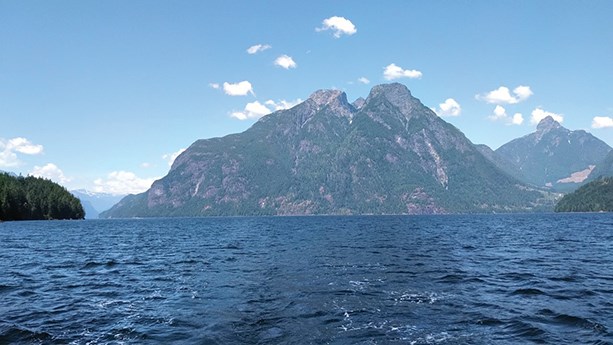After nearly a decade in the making, a proposal to protect Jervis Inlet as a conservation area is now before the provincial government and shíshálh Nation.
On Oct. 26, the Pender Harbour and District Wildlife Society (PHDWS) and the Friends of Caren hosted an online forum about two proposed areas for what would be called the Jervis Inlet Biosphere Conservation Area.
Both proposed areas would extend from the middle of the Sechelt peninsula, covering much of the Sunshine Coast Regional District’s areas A and B, and north to include Princess Louisa Inlet.
The first option would not include Sḵwx̱wú7mesh Úxwumixw (Squamish Nation) territory, and would be approximately 2,800 square kilometres.
The preferred second option would cover approximately 3,000 square kilometers, starting at the middle of the Sechelt peninsula and extending to Squamish Nation territory and north by 100 kilometres. It would include Hotham Sound, Agamemnon Channel, as well as Sechelt, Salmon, Narrows and Princess Louisa Inlets, Chatterbox Falls, and most of Jervis Inlet.
“The whole environment there is absolutely astounding. The rock face is second only to Half Dome in Yosemite Park in terms of its sheer expansiveness, rising from the water up to heights as much as 4,500 feet,” Peter Jones, a member of the Friends of Caren sub-committee, said during the presentation.
Protecting shíshálh Nation and Squamish Nation cultural histories, “as well as supporting biodiversity of the area, are critical features of this proposal.” The establishment of the proposal would mean protection for a range of species including the endangered marbled murrelet and some of the oldest canopy forests in the world. Further federal protection would be needed for marine species such as salmon, several whale species, and the threatened North Pacific rockfish.
In July, Paul and Peter Jones of Friends of Caren gave a presentation to a committee reviewing land use proposals after being invited to provide input on the shíshálh-B.C. Land Use Plan in January 2021. The plan, which is in its first phase, stems from the Foundation Agreement signed in 2018.
The joint land use plan can pertain to those lands or waters in the shíshálh Nation swiya (territory) currently under both shíshálh and B.C.’s jurisdiction for sustainable land and resource stewardship, Jeff Juthans, a provincial land and resource specialist who co-chairs the planning table, told Coast Reporter in January 2021.
The plan “will set the strategic direction to guide sustainable resource stewardship and management of lands and waters in the swiya to meet economic, environmental, social, and cultural objectives at a broad scale,” Juthans added.
The land use planning process will be carried out in four phases, with a draft plan expected to be completed in 2023. The volunteers expect to hear back about the Friends of Caren proposal in spring or summer 2022, when there will be an amalgamation of sorts of the received proposals, Peter Jones told Coast Reporter.
The conservation group’s efforts to see Jervis Inlet identified as a national biosphere conservation area began around 2012. In the 1990s, the Friends of Caren were successful in their push to create Spipiyus Provincial Park in the Sechelt Peninsula’s Caren Range, which protects nesting habitat for the endangered marbled murrelets, as well as old growth trees.
If the current proposal goes forward, the volunteers anticipate tourism in the region could triple.
Powell River-Sunshine Coast MLA Nicholas Simons attended the Oct. 26 Zoom presentation, and suggested some lessons could be learned from the recent declaration of Howe Sound as a UNESCO biosphere region.
“I’m really pleased you’re pursuing this, and I’m pleased that the shíshálh Nation and the province are with you as the proposal gets put forward,” Simons said.
Those seeking more information about the proposal or who would like to comment or provide support, can email [email protected].
– With files from John Gleeson



